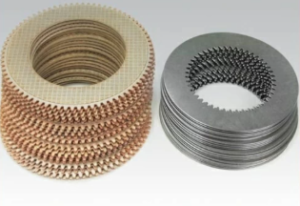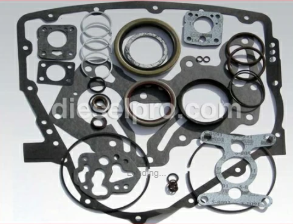
Even with proper servicing and scheduled maintenance, marine transmissions are exposed to some of the harshest operating conditions on the planet—vibration, heat, saltwater corrosion, and extreme torque loads. The Twin Disc MG5114A is built for durability, but like any mechanical system, it can develop performance issues over time.
Understanding the early warning signs of failure can save thousands of dollars and prevent on-the-water emergencies. Whether you’re noticing delayed shifting, gear slippage, strange noises, or signs of an oil leak, this guide will walk you through the most common problems, how to diagnose them, and how to resolve them using field-proven strategies.

Parts Catalog for Twin Disc MG5114A Marine Transmissions
Plate Kit For Twin Disc MG5114A Marine Transmission
Gasket Kits For Twin Disc MG5114A Marine Transmission
Hard Shifting or No Engagement
Nothing is more frustrating—or dangerous—than shifting into forward or reverse and getting no response. A properly functioning MG5114A should engage quickly and smoothly when the clutch pack is pressurized by the hydraulic system.
If the gear hesitates, engages with a hard jolt, or doesn’t engage at all, it’s time to investigate.
Possible Causes:
- Low hydraulic pressure: Without adequate pressure, the clutch packs can’t engage fully.
- Control valve issues: Sticking or blocked spool valves can prevent fluid from reaching the clutch.
- Faulty solenoids (if electronically controlled): Electrical problems can interfere with clutch actuation.
- Incorrect or contaminated fluid: Water-contaminated oil or use of multigrade oils can reduce hydraulic performance.
- Air in the hydraulic system: Air pockets lead to delayed or incomplete engagement.
Immediate Checks:
- Check the oil level – Low oil is the #1 cause of poor engagement.
- Inspect oil condition – Burnt, milky, or foamy fluid should be drained immediately.
- Check pressure readings – Use a gauge on the test port. Pressure should be between 200–300 PSI in gear.
- Examine control linkage or solenoid signal – Make sure mechanical levers or electronic signals are reaching the valve.
Pro Tip: If your MG5114A has a mechanical shift lever, inspect for loose or corroded linkages. For electronic setups, test continuity and power at the solenoids.
Solutions:
- Top off or replace oil with correct SAE grade.
- Bleed the hydraulic system to remove air.
- Remove and clean the control valve body.
- Replace solenoids or faulty wiring if applicable.
- If the pump fails to produce pressure, the oil pump may require inspection or replacement.
Field Example:
A shrimp boat out of Texas reported no forward gear after anchoring. After verifying that the shift linkage was moving correctly, pressure testing revealed only 80 PSI. The problem? A cracked suction hose on the intake side of the pump introducing air. Replacing the hose and refilling with fresh SAE 40 restored pressure and gear function.
Slipping in Forward or Reverse
Slipping gears—where the engine revs but the propeller fails to maintain speed or loses thrust—usually point to clutch pack issues or fluid-related problems. A healthy MG5114A should engage firmly and hold RPMs under load.
Possible Causes:
- Worn or burned clutch discs: Friction material can degrade from heat or hours of service.
- Overheating transmission oil: High temps lower oil viscosity and reduce clutch effectiveness.
- Incorrect oil: Too light or detergent-based oils will cause slippage.
- Low hydraulic pressure: Can’t hold the clutch packs together under torque.
- Faulty valve regulation: Pressure isn’t being delivered properly to the engaged clutch pack.
Visual Indicators:
- Engine RPMs rise without corresponding prop thrust.
- Audible “whirring” or “buzzing” when shifting into gear.
- Overheated housing or burning oil smell in the engine room.
- Blackened or dark oil on dipstick, sometimes with a metallic shimmer.
Solutions:
- Drain and inspect the oil for debris or discoloration.
- Conduct a stall test (consult OEM guidelines) to measure clutch hold capacity.
- Remove and inspect clutch discs and separator plates for wear, glazing, or blue heat marks.
- Check pressure with the gauge—ensure minimum operating PSI is reached under load.
- Replace damaged or worn clutch discs as a complete matched set to maintain balance.
Important: If the transmission slips for more than a few minutes, you risk warping clutch plates, damaging the pump, and contaminating the entire oil circuit.
Prevention:
- Use correct oil grade (SAE 30 or 40 non-detergent).
- Monitor oil temperature regularly.
- Replace clutch discs every 5,000–10,000 hours or at signs of slippage.
Abnormal Noise or Vibration
The MG5114A is normally quiet and well-behaved during operation. When new sounds or vibrations show up, it usually means something is misaligned, worn out, or coming loose internally.
Common Noises:
- Grinding: Usually a bearing issue or gear damage.
- Whining: Could mean worn gears or low oil.
- Thumping: Often caused by misaligned shafts or loose bolts.
- Rattling: Damaged damper plate or worn splines.
Possible Causes:
- Input or output bearing failure
- Gear backlash beyond spec
- Loose or cracked mounting feet
- Worn engine mounts causing misalignment
- Bent output shaft or flange runout
Vibration Symptoms:
- Gear housing shakes at specific RPMs
- Vibration increases under load
- Coupling bolts back out over time
- Excessive wear on output shaft seals
Inspection Steps:
- Use a dial indicator to check output shaft runout.
- Verify engine-to-transmission alignment with feeler gauges or laser tools.
- Check backlash by rotating the shaft manually and measuring free play.
- Listen with a stethoscope (or screwdriver to the ear) for bearing noise.
- Check mount bolts and brackets for looseness or cracks.
Fixes:
- Replace damaged bearings—don’t reuse once they’ve pitted or lost preload.
- Shim or realign engine and transmission flanges to within 0.003” total indicated runout.
- Rebalance or replace the propeller shaft if vibration persists downstream.
- Replace worn dampers or couplings with engine off and transmission supported.
Pro Tip: If the transmission only vibrates at one specific RPM, the cause is likely harmonic—not mechanical. A dynamic balancing test of the driveline may be needed.
Oil Leaks

Oil leaks aren’t just messy—they are often the first sign of internal pressure issues, worn seals, or faulty gaskets. Left unchecked, a minor leak can become a major problem that ruins the entire gear.
Common Leak Points:
- Input shaft seal – Between the engine and the front housing
- Output flange seal – Where the shaft connects to the propeller coupling
- Side access covers – Poor gasket seating or corrosion
- Oil cooler ports and fittings – Damaged O-rings or overtightened adapters
- Dipstick or breather vents – Caused by internal over-pressurization
- Drain plug or filter seal – Old gaskets or incorrect installation
Diagnosing the Source:
- Clean the entire housing and observe after running for 10–15 minutes
- Use UV dye and a black light to trace small leaks
- Inspect under the transmission with a mirror
- Remove bell housing inspection cover to check input seal from behind
On horizontal engines, oil often travels along the housing and appears at a low point—don’t assume the leak is where the puddle appears.
Proper Seal Replacement Guidance:
- Drain fluid before removing seals.
- Use a seal puller or press—don’t pry against the housing.
- Inspect shaft surface for grooves—install a speed sleeve if needed.
- Lubricate the new seal lip before installation.
- Use a seal driver or socket that fits evenly—never hammer directly.
- Reinstall and test after 15–20 minutes of runtime.
Thread Sealant and Gasket Best Practices:
- Use marine-grade thread sealant for cooler line fittings, not plumber’s tape.
- For gasket surfaces:
- Clean with brake cleaner and razor blade
- Apply a thin layer of high-temp RTV or anaerobic sealant if permitted
- Use new gaskets whenever available
- Torque evenly in a star pattern
Avoid over-tightening aluminum or cast iron covers—this often causes cracking or leaks.
Long-Term Leak Prevention:
- Replace O-rings on oil coolers every 1–2 years
- Clean and reseal breather caps every 6 months
- Check hose clamps and hose condition quarterly
- Use stainless steel fasteners in saltwater environments where applicable
Troubleshooting Summary Table
| Symptom | Common Cause | Recommended Action |
| No gear engagement | Low hydraulic pressure | Check fluid, bleed system, inspect valve |
| Slipping under load | Burnt clutch discs, overheated oil | Change oil, replace clutch pack |
| Grinding or humming noise | Worn bearings or gear misalignment | Inspect and replace damaged components |
| Vibration at speed | Misalignment, bad mounts | Check shaft runout, re-align engine and gear |
| Oil on engine bed | Output/input seal leak | Clean and replace seals, check for pressure |
Final Thoughts on Troubleshooting the MG5114A
The Twin Disc MG5114A is a rock-solid marine gear—but no mechanical system is immune to wear, abuse, or oversight. Early identification and action are key. Most issues start small: a delay in engagement, a few drops of oil, or a faint whine. Left unaddressed, these can become expensive failures requiring full removal and overhaul.
By staying vigilant and following the guidance in this section, you can:
- Prevent costly rebuilds
- Increase transmission life by 10,000+ hours
- Maintain operational readiness for your vessel
- Protect your investment and your crew

Parts Catalog for Twin Disc MG5114A Marine Transmissions
Plate Kit For Twin Disc MG5114A Marine Transmission
Gasket Kits For Twin Disc MG5114A Marine Transmission
Videos About Twin Disc Transmissions
6 Reasons Your Twin Disc Transmission Has Low Oil Pressure
7 Reasons Your Twin Disc Transmission Is Overheating
3 Reasons Your Clutch Plates in Your Twin Disc Transmission Are Making Excessive Noise
Bull Gear On A Twin Disc Transmission
Rebuilt Twin Disc Transmissions



 Free US Calls: 1-888-433-4735
Free US Calls: 1-888-433-4735 International: 305-545-5588
International: 305-545-5588